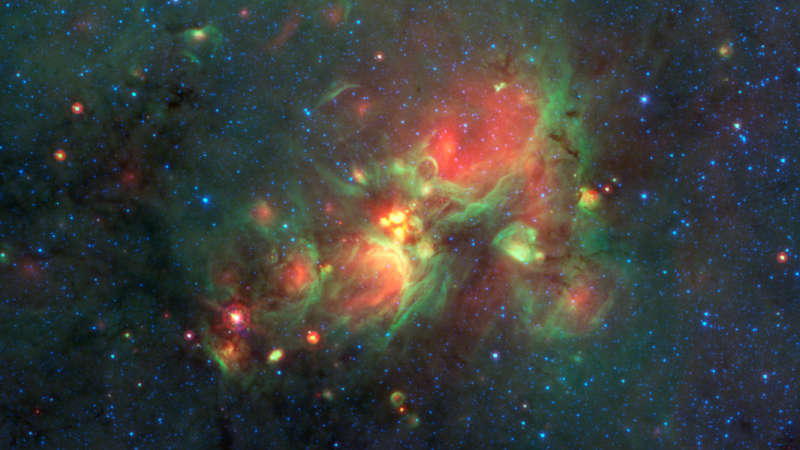
|
Credit & Copyright: NASA/JPL-Caltech
Explanation:
Infrared
wavelengths of 3.6, 8.0, and 24.0 microns
observed by the Spitzer Space Telescope are mapped
into visible colors red, green, and blue in this striking image.
The cosmic cloud of gas and dust is W33, a massive starforming
complex some 13,000 light-years
distant, near the plane of our Milky Way Galaxy.
So what are all those yellow balls?
Citizen scientists of the web-based
Milky Way Project
found the features they called yellow balls as
they scanned many Spitzer images and persistently asked that question
of researchers.
Now there is an answer.
The
yellow balls in Spitzer images
are identified as an early stage of massive star formation.
They appear yellow because they are overlapping regions of
red and green, the assigned colors that correspond to
dust and organic molecules known as PAHs at Spitzer wavelengths.
Yellow balls represent the stage before newborn massive
stars clear out cavities in their surrounding gas and dust
and appear as green-rimmed bubbles with red centers in the Spitzer
image.
Of course, the astronomical crowdsourcing success story is only part of
the Zooniverse.
The Spitzer image spans 0.5 degrees
or about 100 light-years at the estimated distance of W33.
|
January February March April May June July August September October November December |
| ||||||||||||||||||||||||||||||||||||||||||||||||
NASA Web Site Statements, Warnings, and Disclaimers
NASA Official: Jay Norris. Specific rights apply.
A service of: LHEA at NASA / GSFC
& Michigan Tech. U.
Based on Astronomy Picture
Of the Day
Publications with keywords: star formation - infrared
Publications with words: star formation - infrared
See also:
- APOD: 2025 December 9 Á The Heart of the Soul Nebula
- APOD: 2025 July 10 Á Lynds Dark Nebula 1251
- APOD: 2025 June 23 Á W5: Pillars of Star Formation
- APOD: 2025 April 28 Á Gum 37 and the Southern Tadpoles
- APOD: 2025 March 26 Á Star Formation in the Pacman Nebula
- APOD: 2025 February 23 Á Saturn in Infrared from Cassini
- APOD: 2024 October 22 Á M16: Pillars of Star Creation
